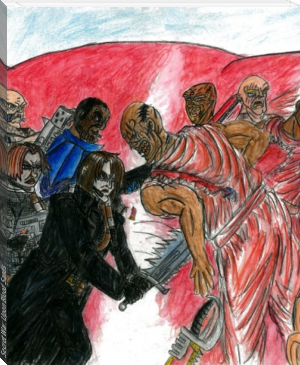Farewell to the Master by H. G. Winter (story books to read .TXT) 📖

- Author: H. G. Winter
- Performer: -
Book online «Farewell to the Master by H. G. Winter (story books to read .TXT) 📖». Author H. G. Winter
Farewell to the Master
by Harry Bates
Astounding Stories of Science Fiction, Issue #1, Jan. 1940
Copyright un-renewed.
From his perch high on the ladder above the museum floor, Cliff Sutherland studied carefully each line and shadow of the great robot, then turned and looked thoughtfully down at the rush of visitors come from all over the Solar System to see Gnut and the traveler for themselves and to hear once again their amazing, tragic story.
He himself had come to feel an almost proprietary interest in the exhibit, and with some reason. He had been the only freelance picture reporter on the Capitol grounds when the visitors from the Unknown had arrived, and had obtained the first professional shots of the ship. He had witnessed at close hand every event of the next mad few days. He had thereafter photographed many times the eight-foot robot, the ship, and the beautiful slain ambassador, Klaatu, and his imposing tomb out in the center of the Tidal Basin, and, such was the continuing news value of the event to the billions of persons throughout habitable space, he was there now once more to get still other shots and, if possible, a new “angle.”
This time he was after a picture which showed Gnut as weird and menacing. The shots he had taken the day before had not given quite the effect he wanted, and he hoped to get it today; but the light was not yet right and he had to wait for the afternoon to wane a little.
The last of the crowd admitted in the present group hurried in, exclaiming at the great pure green curves of the mysterious time-space traveler, then completely forgetting the ship at sight of the awesome figure and great head of the giant Gnut. Hinged robots of crude manlike appearance were familiar enough, but never had Earthling eyes lain on one like this. For Gnut had almost exactly the shape of a man — a giant, but a man — with greenish metal for man’s covering flesh, and greenish metal for man’s bulging muscles. Except for a loin cloth, he was nude. He stood like the powerful god of the machine of some undreamt-of scientific civilization, on his face a look of sullen, brooding thought. Those who looked at him did not make jests or idle remarks, and those nearest him usually did not speak at all. His strange, internally illuminated red eyes were so set that every observer felt they were fixed on himself alone, and he engendered a feeling that he might at any moment step forward in anger and perform unimaginable deeds.
A slight rustling sound came from speakers hidden in the ceiling above, and at once the noises of the crowd lessened. The recorded lecture was about to be given. Cliff sighed. He knew the thing by heart; had even been present when the recording was made, and met the speaker, a young chap named Stillwell.
“Ladies and gentlemen,” began a clear and well-modulated voice — but Cliff was no longer attending. The shadows in the hollows of Gnut’s face and figure were deeper; it was almost time for his shot. He picked up and examined the proofs of the pictures he had taken the day before and compared them critically with the subject.
As he looked a wrinkle came to his brow. He had not noticed it before, but now, suddenly, he had the feeling that since yesterday something about Gnut was changed. The pose before him was the identical one in the photographs, every detail on comparison seemed the same, but nevertheless the feeling persisted. He took up his viewing glass and more carefully compared subject and photographs, line by line. And then he saw that there was a difference.
With sudden excitement, Cliff snapped two pictures at different exposures. He knew he should wait a little and take others, but he was so sure he had stumbled on an important mystery that he had to get going, and quickly folding his accessory equipment he descended the ladder and made his way out. Twenty minutes later, consumed with curiosity, he was developing the new shots in his hotel bedroom.
What Cliff saw when he compared the negatives taken yesterday and today caused his scalp to tingle. Here was a slant indeed! And apparently no one but he knew! Still, what he had discovered, though it would have made the front page of every paper in the Solar System, was after all only a lead. The story, what really had happened, he knew no better than anyone else. It must be his job to find out.
And that meant he would have to secrete himself in the building and stay there all night. That very night; there was still time for him to get back before closing. He would take a small, very fast infrared camera that could see in the dark, and he would get the real picture and the story.
He snatched up the little camera, grabbed an aircab and hurried back to the museum. The place was filled with another section of the ever-present queue, and the lecture was just ending. He thanked Heaven that his arrangement with the museum permitted him to go in and out at will.
He had already decided what to do. First he made his way to the “floating” guard and asked a single question, and anticipation broadened on his face as he heard the expected answer. The second thing was to find a spot where he would be safe from the eyes of the men who would close the floor for the night. There was only one possible place, the laboratory set up behind the ship. Boldly he showed his press credentials to the second guard, stationed at the partitioned passageway leading to it, stating that he had come to interview the scientists; and in a moment was at the laboratory door.
He had been there a number of times and knew the room well. It was a large area roughly partitioned off for the work of the scientists engaged in breaking their way into the ship, and full of a confusion of massive and heavy objects — electric and hot-air ovens, carboys of chemicals, asbestos sheeting, compressors, basins, ladles, a microscope, and a great deal of smaller equipment common to a metallurgical laboratory. Three white-smocked men were deeply engrossed in an experiment at the far end. Cliff, waiting a good moment, slipped inside and hid himself under a table half buried with supplies. He felt reasonably safe from detection there. Very soon now the scientists would be going home for the night.
From beyond the ship he could hear another section of the waiting queue filing in — the last, he hoped, of the day. He settled himself as comfortably as he could. In a moment the lecture would begin. He had to smile when he though of one thing the recording would say.
Then there it was again — the clear, trained video of the chap Stillwell. The foot scrapings and whispers of the crowd died away, and Cliff could hear every word in spite of the great bulk of the ship lying interposed.
“Ladies and gentlemen,” began the familiar words, “the Smithsonian Institution welcomes you to its new Interplanetary Wing and to the marvelous exhibits at this moment before you.”
A slight pause.
“All of you must know by now something of what happened here three months ago, if indeed you did not see it for yourself in the telescreen,” the voice went on. “The few facts are briefly told. A little after 5:00 p.m. on September 16th, visitors to Washington thronged the grounds outside this building in their usual numbers and no doubt with their usual thoughts. The day was warm and fair. A stream of people was leaving the main entrance of the museum, just outside in the direction you are facing. This wing, of course, was not here at that time. Everyone was homeward-bound, tired no doubt from hours on their feet, seeing the exhibits of the museum and visiting the many buildings on the grounds nearby. And then it happened. On the area just to your right, just as it is now, appeared the time-space traveler. It appeared in the blink of an eye. It did not come down from the sky; dozens of witnesses swear to that; it just appeared. One moment it was not here, the next it was. It appeared on the very spot it now rests on.”
“The people nearest the ship were stricken with panic and ran back with cries and screams. Excitement spread out over Washington in a tidal wave. Radio, television, and newspapermen rushed here at once. Police formed a wide cordon around the ship, and army units appeared and trained guns and ray projectors on it. The direst calamity was feared. For it was recognized from the very beginning that this was no spaceship from anywhere in the Solar System. Every child knew that only two spaceships had ever been built on Earth, and none at all on any of the other planets and satellites; and of those two, one had been destroyed when it was pulled into the Sun, and the other had just been reported safely arrived on Mars. Then, the ones made here had a shell of a strong aluminum alloy, while this one, as you see, is of an unknown greenish metal.”
“The ship appeared and just sat here. No one emerged, and there was no sign that it contained life of any kind. That, as much as any single thing, caused excitement to skyrocket. Who, or what, was inside? Were the visitors hostile or friendly? Where did the ship come from? How did it arrive so suddenly right on this spot without dropping from the sky?”
“For two days the ship rested here, just as you now see it, without motion or sign that it contained life. Long before the end of that time the scientists had explained that it was not so much a spaceship as a space—time traveler, because only such a ship would arrive as this one did — materialize. They pointed out that such a traveler, while theoretically understandable to us Earthmen, was far beyond attempt at our present state of knowledge, and that this one, activated by relativity principles, might well have come from the far corner of the Universe, from a distance which light itself would require millions of years to cross.”
“When this opinion was disseminated, public tension grew until it was almost intolerable. Where had the traveler come from? Who were its occupants? Why had they come to Earth? Above all, why did they not show themselves? Were they perhaps preparing some terrible weapon of destruction?”
“And where was the ship’s entrance port? Men who dared go look reported that none could be found. No slightest break or crack marred the perfect smoothness of the ship’s curving ovoid surface. And a delegation of high-ranking officials who visited the ship could not, by knocking, elicit from its occupants any sign that they had been heard.”
“At last, after exactly two days, in full view of tens of thousands of persons assembled and standing well back, and under the muzzles of scores of the army’s most powerful guns and ray projectors, an opening appeared in the wall of the ship, and a ramp slid down, and out stepped a man, godlike in appearance and human in form, closely followed





Comments (0)